The mobile revolution is creating a new buzz in businesses, and the eCommerce space is no exception. Mobile eCommerce apps for your business are changing how online shopping is done. Thus, lead you a step ahead in the competitive retail sector to win the extra mile.
Thanks to modern technology, mobile apps are becoming an irreplaceable part of every business. They have changed how retailers can connect with their customers. There is no more dependency on bulletin boards or printing materials to promote special offers or discounts when you can do it more productively through a mobile eCommerce app.

Mobile eCommerce development is fundamentally driven by customers using mobile gadgets to purchase goods and services.
With everything heading in the mobile direction, your eCommerce store will only reach its full potential with a mobile app complementing it.
Digital-first mobile retail solutions are no longer a nice-to-have but a need-to-have.
– Forbes
What is Mobile eCommerce, and Why Does Your Business Need It?
Your business is in danger if you miss the importance of mobile eCommerce. E-commerce’s rise over the past five to ten years has demonstrated its importance for businesses transitioning to a more online society.
The growing importance of mobile eCommerce
Developing scalable mobile apps that enable you to adapt as your customer base expands and changes are crucial to any digital-first strategy and essential to enterprises’ survival. The introduction of eCommerce has already marked a significant advancement in how we shop. Customers could access a broader selection of products, rapidly compare prices, and buy from the comfort of their homes if they could shop from their desktop computer rather than going into a store.
How Mobile eCommerce Apps Benefit Your Business
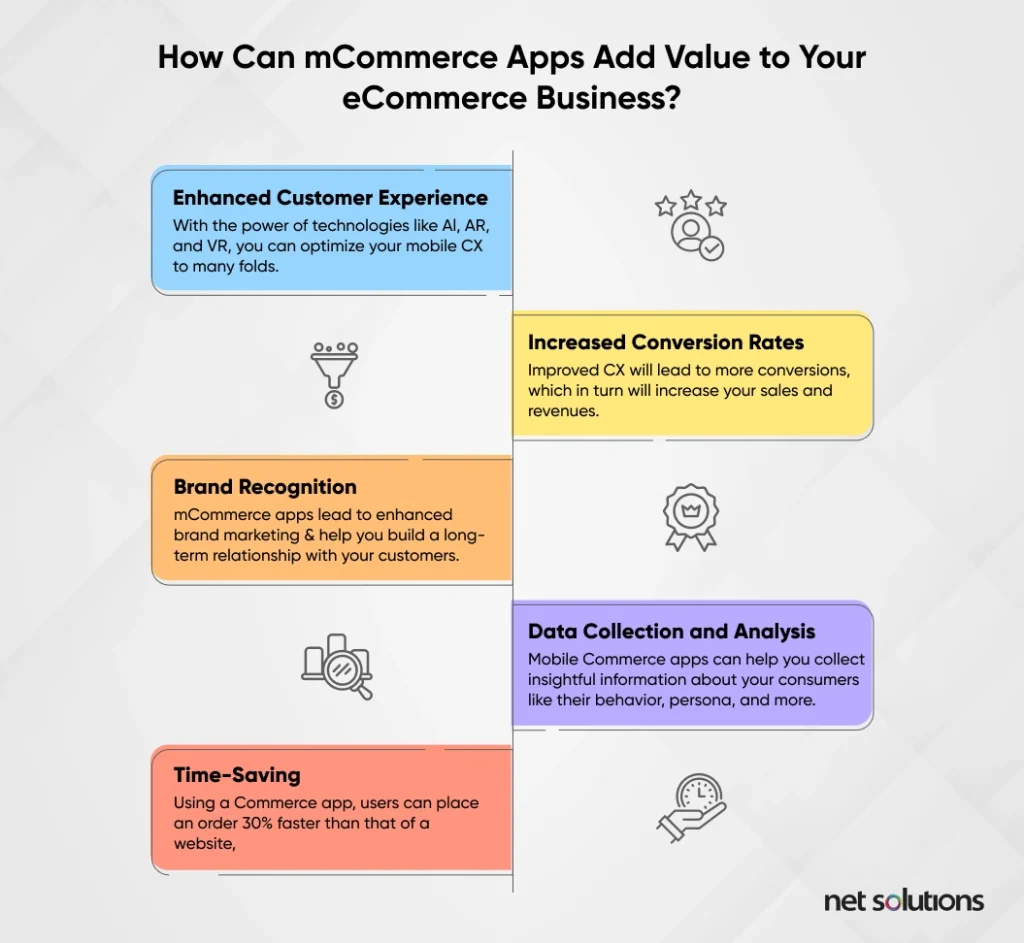
The mCommerce industry is flourishing, and it’s high time to develop an app for your eCommerce business by choosing the right mobile app development team. The eCommerce market has seen a substantial rise in the popularity of mobile commerce, which is expected to continue. Social media sites, including Meta (previously Facebook), Twitter, Pinterest, and Instagram, included “buy buttons” on their mobile platforms around the middle to end of the 2010s, allowing users to effortlessly buy products from other businesses directly from these social media sites. Let’s check out how a Mobile eCommerce App can add value to your business:
1. Direct-to-customer marketing channel
The customer-first approach is an elixir for any business; How can it benefit your business? Let’s learn it from Zomato.
a. Push notifications
Zomato drives 1.5 million orders daily!
Push notifications might be a tiny part of your marketing approach, but if utilized correctly, they can work wonders for your business – as they have for Zomato.
Today, with the help of mobile gadgets, customers are 24 x 7 associated with brands. These mobile devices have also changed how we interact with brands, acquire information, and shop. To leverage the potential of connected customers, brands must offer consistent and steady involvement via mobile eCommerce.
b. Personalized content
Customers increasingly use mobile devices to shop, and businesses must incorporate these devices into their marketing strategy. This helps to change the interaction between the customers and the brand. Mobile commerce app not only helps customers stay connected with the brand but can also be used to deliver deals, offers, and coupons effectively. Make sure you personalize your marketing approach.
2. Enhanced customer experience
Global consumerism has significantly transitioned in the last ten years. Due to its convenience, the sharp increase in internet purchasing is preferred over traditional brick-and-mortar stores. And so, you must focus on building a satisfactory customer experience.
a. User-friendly interface
Today’s potential customers want more than just to buy a product when they visit an e-commerce website. They also desire a user-friendly, hassle-free, and preferably memorable shopping experience. And that needs to be satisfied with a user-friendly approach.
b. Advanced search capabilities
You might have hundreds, thousands, or even millions of products, but if they are difficult to search, customers will need help locating and buying what they want. Anyone operating an online store knows how crucial site search is to the user experience.
A simple search could turn into a sale – or a missed opportunity depending on how quickly and easily shoppers can find your products using information like name, size, color, or SKU. The advanced search extends beyond the standard search box that customers use online. Brands can target user intent and fine-tune the search and discovery criteria, displaying results swiftly and precisely.
c. Seamless checkout process
Offering a superior customer experience is at the heart of direct-to-consumer marketing, which is crucial in checkout. The term “smooth checkout” describes a straightforward process that streamlines a customer’s purchasing experience so they may finish their transaction quickly. Offering customers a seamless experience can:
- Boost retention
- Lower the overall cost of acquisition
Modern-day customers demand personalized and consistent experiences throughout their journey with a brand. And that isn’t possible using only a website as a channel to deal with your customers. If you want them to always return to your brand, mobile apps can make it easy for you.
With the power of emerging technologies like Artificial Intelligence, Machine learning, AR & VR combined in a Mobile eCommerce App, you can gather valuable insights about your users, such as:
- What do your users like? At what time of day do they make buying decisions?
- How long do they take before decide what to buy?
Once you have all this data, you can provide your consumers with an optimized shopping experience to increase sales.
3. Better conversion rate
There is no doubt that mobile eCommerce apps drive higher conversion rates. And, in the end, it’s the only thing that matters because it results in revenue. You can follow the below steps to help boost your conversion.

a. Faster load times
Speed = Revenue Customers’ tolerance is tested when a page loads slowly on a mobile device. You might lose a sale due to a “fail” in the customer experience. Also, a lengthy loading time reduces the likelihood that they will visit again. Ensure your website loads as rapidly as possible, especially on mobile devices, if you want customers to buy from you.
b. User account creation
While forced account registration is still a significant purchase barrier, offering a unified shopping experience to customers who create logins on eCommerce sites is much simpler. This convenience of multi-touchpoint access to personal shopping information can also be a significant selling point.
An eCommerce solution that caters to mobile and desktop shoppers and combines back-end systems so that order management and fulfillment capabilities can draw from the same profile could boast seamless sign-on connection with omnichannel services.
c. One-click ordering
The checkout process is simple, with the ability to purchase with only one click. Also, consumers will never have to experience a circumstance when their preferred mode of payment is rejected. Instead, customers can pay automatically using a method they’ve already selected. You can also integrate mobile wallet apps in your mCommerce app to make the checkout process a one-step game. These apps minimize the information users must enter while completing the checkout process.
So, if you are an eCommerce business owner thinking, “Why do I need a mobile app”? Achieving better conversion rates is your answer. When customers want to buy a product, they desire a seamless purchasing process, and you can set it in the best possible way using a mobile app. There are many reasons why:
- Mobile apps have features like push notifications that help in conversions.
- Mobile apps have all the information (payment and shipping) saved for easy checkouts.
- Mobile apps can use device features like cameras for placing orders.
- mCommerce is easier and more convenient than other channels, increasing profitability.
4. Brand recognition
A brand needs to offer a high-quality mobile app experience that users love. Since maximum customers spend hours on their mobile, it becomes easy for brands to connect with them using a mobile ecommerce platform.
a. Increased visibility
Increased brand visibility is one of the best advantages of Mobile Commerce and a solid reason to go for Mobile eCommerce App development.
Because on small screens, users get irritated fast, and as per Statista, 32% of app users uninstall an app if they don’t find it easy to use, which leads to a bad UX.
b. Customization options
Marketers need to know their target audience’s characteristics and needs. If you want to give your consumers a more tailored experience, it’s imperative to understand them better.
c. Social media integration
Leverage smart branding tactics with beautiful UI/UX designs to create a lasting impression on mobile customers using social media. Also, to make your eCommerce app branding more effective, you must answer all your customers’ queries.
The more the brand knows about its customers, the better it will be at answering the pain points.
5. Better efficiency and increased revenues
Companies must stay competitive in the rapidly evolving mobile commerce landscape and optimize their operations to drive sales and revenue growth. Here are a few steps you can take for a solid start.
a. Inventory management
Inventory management in mobile commerce enables firms to maintain the ideal inventory level to satisfy customer demand while reducing costs and optimizing profits. Businesses may prevent stockouts and give customers a satisfying shopping experience by ensuring products are accessible. Businesses may improve their supply chains and increase profitability by using effective inventory management to assist them in deciding which products to buy and how much to stock.
b. Analytics and reporting
Analytics and reporting are essential in mobile commerce because they give businesses valuable insights into customer behavior, trends, and performance metrics. By tracking and analyzing data such as website traffic, conversion rates, and customer demographics, businesses can identify areas for improvement and make informed decisions about marketing, pricing, and inventory management.
c. Upselling and cross-selling
To grow revenue and client lifetime value, upselling and cross-selling are essential in mobile commerce. Cross-selling and upselling are used to raise a customer’s overall purchase value. Upselling entails convincing customers to buy a product’s more expensive or premium version.
Businesses can efficiently upsell and cross-sell to customers by utilizing mobile commerce’s ease and personalized nature, increasing the shopping experience and generating more purchases. Also, this tactic can increase client loyalty and encourage recurring transactions over time.
Mobile apps are considered more manageable and user-friendly. Despite the fact that their execution is often termed costly, they are usually capable of satisfying customers’ needs and increasing sales significantly.
The correlation is simple: a great mobile app with the right concept and functionality brings more customers. More customers result in more orders, which means your profits are increasing.
6. Customer loyalty
Mobile apps play a crucial role in the brand’s bonding with customers. Gone are the days when businesses prefer roadside banners, website banners, billboards, Facebook/newspaper ads, or email marketing – to create an influence on customers. You can rely on the below approaches to help build a strong customer base.
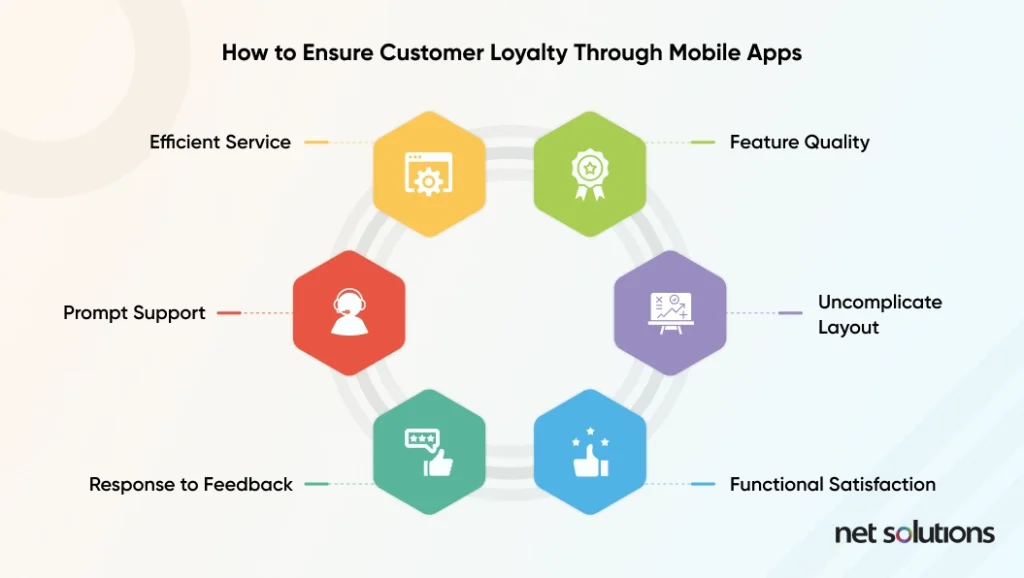
a. Loyalty programs
Loyalty programs are crucial to mobile commerce because they aid firms in cultivating client loyalty and boosting customer retention. Businesses can entice customers to return and buy more by providing rewards, discounts, and other incentives for repeat business.
Platforms for mobile commerce make it simple to run and monitor loyalty programs, allowing companies to customize rewards and promotions depending on consumer behavior and preferences. This strategy can boost consumer involvement, foster brand loyalty, and spur long-term revenue development.
b. Personalized discounts and offers
By utilizing consumer data and insights, businesses can focus on promotions and discounts specific to each client’s interests and behavior. This strategy can boost sales, foster more significant customer interaction, and foster greater customer loyalty. Businesses can send these tailored offers in real-time thanks to mobile commerce systems, which create a smooth and convenient buying experience to help them stand out in a crowded market.
c. Easy returns and refunds
Simple refunds and returns are essential for mobile commerce because they encourage consumer confidence and trust. Because mobile commerce platforms allow customers to shop whenever and from wherever they are, it might be challenging to scrutinize things before purchasing. Businesses can reduce consumer worries and offer peace of mind by providing a simple return and refund procedure, increasing customer satisfaction and repeat business. Also, a quick and easy returns procedure can enhance client satisfaction generally and set a company apart from rivals in the competitive field of mobile commerce
Presently, mobile eCommerce apps are going to save businesses as it helps brands know their customers better by staying closer to them with just a ‘finger tap’.
As customers spend most of their time on mobile apps, ensure that your brand offers product details, and contact information and motivates them to buy. Here are the ways to boost customer loyalty with a mobile eCommerce app:
- A consistent brand value by maintaining a consistent design and layout on a mobile platform on which customers can depend.
- Offering a personalized experience to your customers, including prioritized features and relevant suggestions based on their searches and purchases.
- Use push notifications to communicate with your customers to tell them about sales and special offers or informing the items back in stock.
- You can assist your customers to keep coming back by performing loyalty programs like discounts, offers, bonuses, or new collections.
- Establishing good communication support 24/7 between your brand and customers to solve their queries via live chat or chatbot.
7. Time-saving
Mobile apps load 1.5 times faster than eCommerce websites. Data retrieval in mobile apps happens in a blink of an eye and delights customers by providing them with a seamless shopping experience and saving time. Below are a few processes to assist you in saving time for your customers.
a. Automated processes
Mobile commerce relies heavily on automated processes since they help companies run more smoothly and successfully. Platforms for mobile commerce can streamline businesses by automating tasks like order fulfillment, customer service, and inventory management, which require less manual work overall.
This method can reduce time and expenses while enhancing precision and consistency, reducing costs and higher output. Businesses can provide customers with a more seamless and convenient purchasing experience by using automated processes, increasing customer happiness and loyalty.
b. Voice-activated features
Due to their handy and hands-free nature, they are becoming increasingly significant in mobile commerce. Customers may use them to communicate with businesses and make purchases. The use of voice technology in daily life is increasing due to the popularity of virtual assistants like Siri, Alexa, and Google Assistant.
Businesses may give customers a more natural and intuitive buying experience by incorporating voice-activated capabilities into mobile commerce systems, increasing engagement and loyalty. Additionally, speech technology can help businesses personalize their interactions with clients by making recommendations and presenting deals specific to each client’s tastes and habits.
In the end, what customers like is something that eases their tasks and saves time. And suppose your target audience is Millennials or Gen Z. In that case, you must count every moment while making your marketing strategy because of their shorter attention span (12 seconds for millennials and just 8 seconds for gen Zers).
Now while the reasons mentioned above make it clear that the future of eCommerce is mobile eCommerce apps, the next questions that need to be answered include:
- Is it enough for eCommerce stores to have a mobile app?
- What features does a mCommerce app need to drive sales?
- How to create eCommerce mobile apps that users consider useful?
- How will the mCommerce landscape change in the upcoming years?
- How to make an app for your business that delivers results?
Top eCommerce Mobile App Features for the Next 5 Years
Based on the eCommerce challenges businesses face, the following are some essential features you must add to tackle these challenges and drive conversions and revenues.
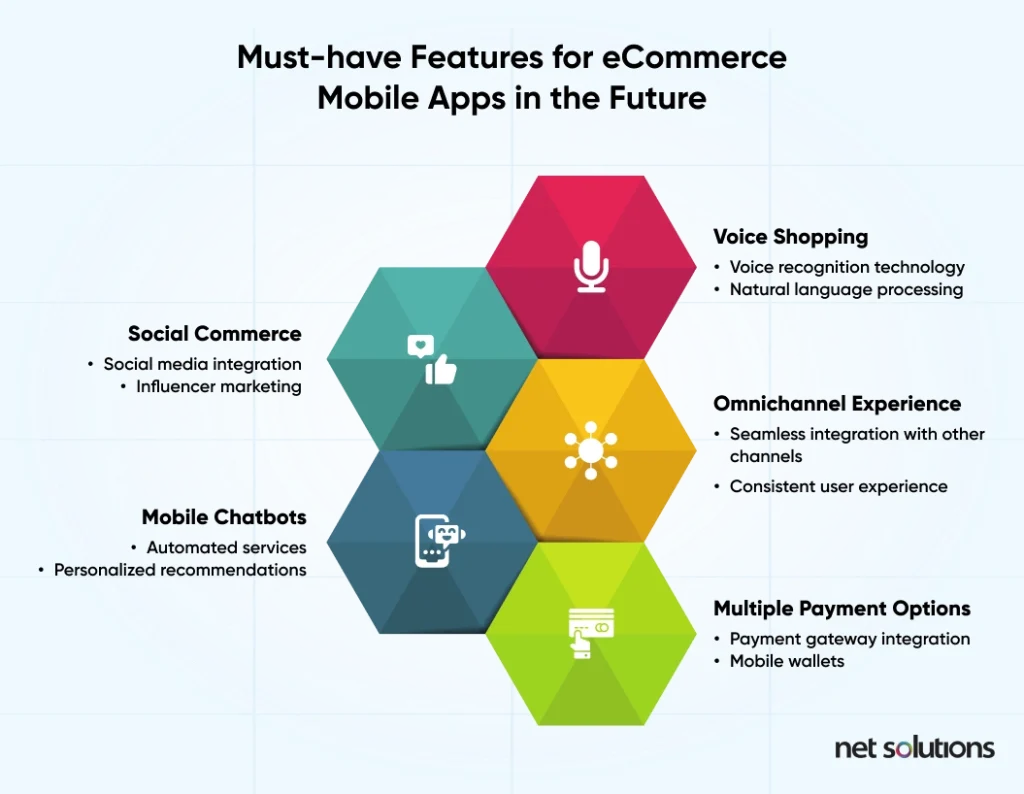
1. Voice shopping
How can businesses use voice technology in their mCommerce apps? The use of voice will no longer be limited to search in the coming years. Let’s understand this more.
a. Voice recognition technology
A voice in Mobile eCommerce Apps is expected to be one of the top eCommerce trends for all the right reasons. Here are three benefits of voice technology to mCommerce:
- Speed: The feature will provide quicker results as voice search is 3.7X faster than typing.
- Convenience: Compared to text searches, voice searches are much more convenient for customers as they just have to speak their query rather than type it.
- Adaptability: ComScore says 50% of all searches will be voice by the end of 2020. This shows how fast people are adapting to this new norm.
For better results, eCommerce business owners should optimize their mCommerce apps to let users do several other things using voice technology, like
- Making a purchase
- Tracking a package
- Contacting support
- Adding items to the cart
- Making payments
Thus, as an eCommerce store owner, if you want to provide your customers with a seamless shopping experience, consider making voice search an important point in the list of your must-have eCommerce mobile app development features to drive profitability for your business.
b. Natural language processing
Natural language processing is essential to mobile commerce because it helps companies comprehend and analyze client comments and inquiries more precisely and effectively. Natural language processing may evaluate client discussions and deliver pertinent comments and suggestions in real-time using artificial intelligence and machine learning. This strategy can improve client satisfaction and experience, increasing sales and money.
Additionally, organizations can use natural language processing to spot patterns and trends in consumer behavior and preferences, gaining crucial information for marketing, product development, and customer service initiatives.
2. Social commerce
Social commerce is not just a buzzword anymore. How can it benefit you – let’s understand more.
a. Social media integration
With apps like Instagram already allowing users to checkout without even leaving the app, this feature will make mCommerce even bigger and more pleasing for customers in the coming years.
Here are some stats of U.S internet users to prove it:
- 43% search for products for purchasing using social media
- 37% say they bought something from social media
- 56% say they are searching on Facebook for holiday shopping ideas
- 55% say they bought after discovering a product on social media.
Thus, to make your eCommerce business competitive in the coming years, it is important to power it using social media. It can help you reach a wider audience, increase customer engagement rate, promote your brand, and generate higher ROI. Since this trend is new (and catching fire), you can utilize it well to create mobile commerce apps effectively.
b. Influencer marketing
Mobile commerce needs influencer marketing since it can expand a company’s audience and increase brand recognition. Influencer marketing has gained popularity as a means for businesses to market their goods and services to a specific audience, thanks to the growth of social media.
Companies can use the followers and authority of relevant influencers to promote their products and raise their visibility by collaborating with them. This strategy may encourage users to shop on mobile commerce platforms, increasing income. Influencer marketing can also assist companies in growing consumer relationships and long-term brand loyalty.
3. Omnichannel experience
With increasing competition in the eCommerce industry, brands are now selling their products on multiple channels like websites, mobile apps, mobile websites, or physical stores. Now let’s understand how you can make an omnichannel strategy using a mCommerce app.
a. Seamless integration with other channels
As an eCommerce store owner, you provide customers with a seamless experience across all channels. For example, if a customer is browsing your mobile eCommerce app and adds an item to the cart to shop later, these items should not be deleted when he opens the e-store website.
You must make sure that all your channels are in sync with each other. As per reports, around 60% of customers start shopping on one device and checkout on a different device. Also, about 80% of customers consult their phones before purchasing in-store.
Suppose a customer searches for a product on your mCommerce app today and a day after he/she reaches your store. So, the best way to provide an omnichannel experience is to target the customer using a push notification related to his/her search. You can give them a discount on that product or simply define your product’s USPs in a short and crisp format.
Remember, a fantastic customer experience is consistent across all touchpoints – offline or online.
b. Consistent user experience
A consistent user experience is essential in mobile commerce because it can significantly impact a company’s performance. Regardless of the platform they are using or the device they are using, mobile customers want seamless and simple experiences with websites and apps. Confusion, annoyance, and customer loss can result from inconsistent experiences. Consistency is critical to building user trust, increasing conversion rates, and cultivating a positive brand for organizations.
4. Mobile chatbots
Mobile chatbots are not new. Some of the best eCommerce mobile apps have used this feature for years. But, in the coming time, their use in mCommerce apps is supposed to increase for performing various functions – how? Let’s take a deep dive into the intricacies.
Automated customer service and personalized recommendations
AI-powered tools can provide your mCommerce apps various benefits like
- Improved CX by offering smart personalization while communicating with the users
- Better analysis of likes, dislikes, and preferences of customers to improve recommendations
- Higher customer engagement of mCommerce apps by communicating with various clients at one time
- Offering 24/7 support for resolving queries and complaints
- Saving time and cost of hiring a human customer support executive
5. Multiple payment options
The mobile payment industry is growing quickly. So, if you are thinking of developing a mCommerce app for your e-store, don’t forget to add multiple mobile wallets or payment gateways to your app. Here’s how you can integrate payment options into your business –
a. Payment gateway integration
Customers use mobile wallets like Apple Pay, Android Pay or Google Pay, Venmo, and Paypal to make purchases. Moreover, these are safe and quick to do the needful in just a few taps.
We all know how annoying it is to re-enter your card details repeatedly to complete a purchase. This is where you can lose a customer forever.
So, to ensure you always win your customers at this step, consider integrating as many payment methods as possible in your app. Also, wearables can be used to complete mobile wallet payments, adding convenience to your customer’s journey.
The more convenience, the more conversions will be.
Now that we have set the context for what eCommerce mobile app features are required to make an impact on your customers – let’s see how to build ecommerce mobile apps to get the benefits they offer.
How to Develop Mobile Apps for eCommerce
From idea to deployment, there is a lot that you need to take care of while building a mobile commerce platform. To find an answer to “How to build an ecommerce app effectively”, you have to consider so many things right, from its ease of navigation to accessibility and technology stack.
All this isn’t possible if you don’t follow a proper procedure. So let’s walk you through the ideal process of developing a mobile app for eCommerce:
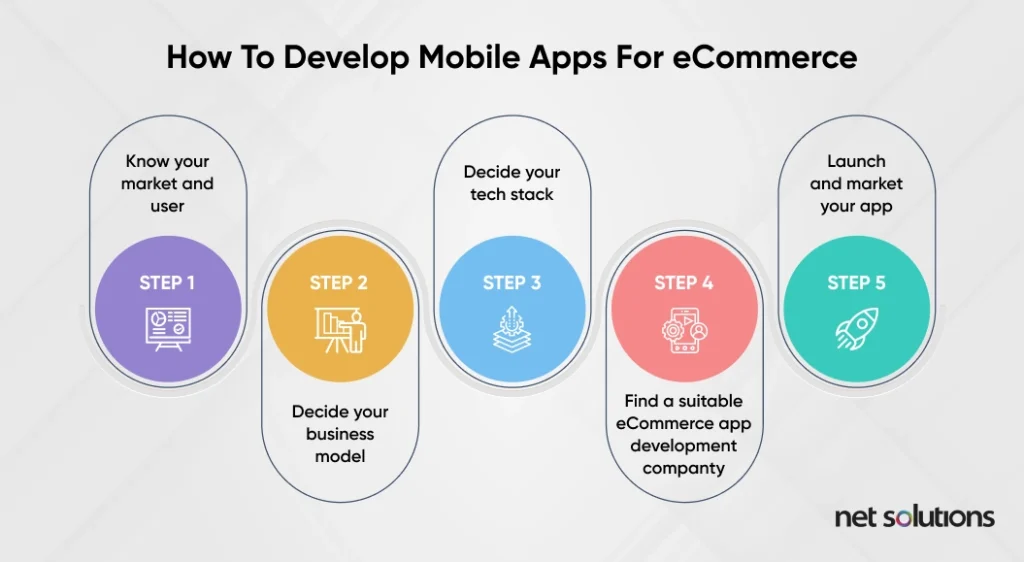
Step 1: Know your market and user
Poor research and less understanding of the market is one of the prominent reasons why mobile apps fail. So, make no mistake and research your market thoroughly before you think about developing your eCommerce app.
a. Identify your target market
To know your market and the need of your users, you must find an answer to the following questions:
- Who is your target audience?
- What is their age group?
- What do they like and dislike the most?
- What products are they using as of now?
All this data will help you create your app as relatable as possible for the people using it. For example, if you are an offline store owner, your customers might like a seamless experience throughout all your touch points – online and offline. On the other hand, if you own an eCommerce business (online only), you might want to focus more on marketing your service on app marketplaces to expand it.
b. Determine your unique value proposition
Consumers have a wide range of mobile commerce options, so it’s critical to determine what makes your company unique and why customers should select you over competitors. A distinct value proposition may draw and keep clients by giving them a strong justification for using your mobile commerce platform.
To make sure that your initiatives are concentrated on providing value to your target audience, it can also help direct your business decisions and plans.
So, discover your goals, know your market and user demand, and move forward.
Step 2: Decide your business model
If you plan to develop an eCommerce app, you must know your business model. Creating a viable business model before developing an app helps you know your value proposition, customer segment, and revenue streams.
Generally, mCommerce mobile apps have one of the following two business models:
- Business to Consumer (B2C): This approach is the most common when setting up an online eCommerce business. Anything you buy in an eCommerce store online is part of a B2C transaction, and examples include Walmart, Wish, and Gap.
- Business to Business (B2B): Using this business model, an eCommerce business sells its products or services to another company online.
Sometimes the buyer may be the end-user. However, oftentimes buyer resells the purchased item to consumers. Its examples include enterprise eCommerce platforms like Boeing.
While selecting a suitable business model for your eCommerce mobile app, spend time knowing about the market and being honest about what value you can bring your users. Making a business model canvas for better understanding is always advisable:
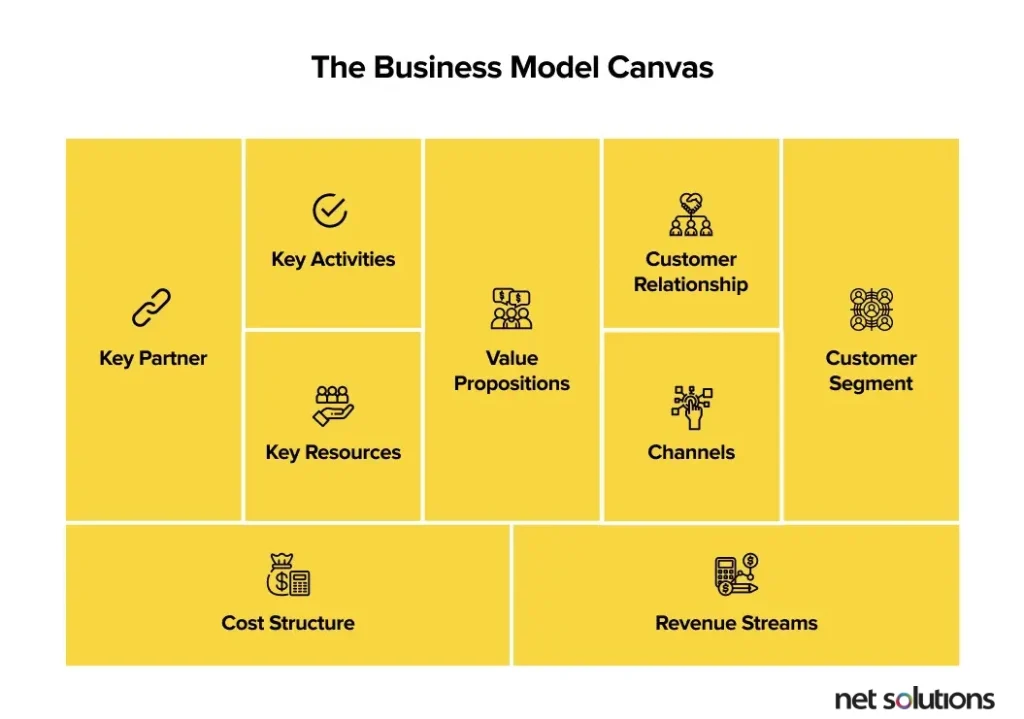
Step 3: Decide your tech stack
Now that you have researched your market and know your app’s business model. It’s time to decide what technologies you will use to develop an eCommerce app. Remember, your decision in this step will directly impact your eCommerce mobile app development cost.
a. Native vs. hybrid apps
It’s crucial to weigh the market when choosing between native and hybrid apps for your mobile commerce platform. The best performance, functionality, and user experience come from native apps, but creating them for other platforms takes more effort and money.
On the other hand, hybrid apps can be created more quickly and inexpensively, but they cannot offer the same functionality and performance as native apps. The decision between native and hybrid will ultimately be based on the resources and needs of your particular organization.
b. Frontend and backend technologies
You must choose your mobile commerce platform’s frontend and backend technologies carefully to provide a seamless and responsive user experience.
Popular front-end programming languages include Swift, Kotlin, and React Native. There are three main frameworks for backend development: Node.js, Ruby on Rails, and Django. It’s crucial to consider variables like scalability, security, and simplicity of integration when choosing your technology.
c. Key features to include
Standard
- Mobile-friendly product catalogs.
- Secure payment processing.
- Real-time inventory tracking.
- Customized suggestions.
It’s also crucial to consider functions like social sharing options, simple checkout, and straightforward navigation that can enhance the user experience. Ultimately, the important components you include will rely on your particular business objectives and target market.
Step 4: Find a suitable eCommerce app development company
Finding a suitable eCommerce app development company for your mobile commerce platform requires thorough research and evaluation of potential partners. To select a suitable company, you must follow the below points –
a. Research and evaluate potential partners
Look for companies with a strong portfolio of successful projects, relevant experience in your industry, and positive client testimonials.
It’s also essential to consider factors such as the company’s size, expertise, and technology stack to ensure they can meet your specific needs.
b. Get a detailed proposal and timeline
Once you have identified potential partners, requesting a detailed proposal and timeline for your project is crucial. This should include a breakdown of the project scope, timeline, budget, and any potential risks or challenges. Reviewing the proposal thoroughly and asking questions or clarifying any concerns before moving forward is important.
c. Ensure regular communication and collaboration
Regular communication and collaboration are essential for a successful eCommerce app development project. Ensure your chosen partner has a clear communication plan, with regular status updates and checkpoints.
Establishing a project management framework that allows for collaboration and feedback throughout the development process is also important. Regular communication and collaboration can ensure that the project stays on track and that any issues or concerns are addressed promptly.
When finding an eCommerce app development company for your project, always ensure the company has expertise in delivering outstanding digital customer experiences.
Check their portfolio, talk to their clients, inquire about their development process, and find their proficiency in integrating emerging technologies required in a mCommerce app today. Double-check everything and then decide your development partners. Also, once your app is developed, don’t forget to invest in ecommerce mobile app testing to make sure your app is bug-free and works seamlessly.
Step 5: Launch and market your app
It is important to focus on the pre and post-launch strategies to grow your mobile app. The below tactics will help you establish your brand the right way.
a. App store optimization
App store optimization is crucial for ensuring your mobile commerce app is discoverable and visible to potential users. This includes optimizing your app’s title, description, and keywords to improve search rankings and creating appealing app icons and screenshots encouraging users to download and try your app.
b. Monitoring user feedback
Monitoring and responding to user reviews and feedback is also important, as this can help improve your app’s overall rating and visibility in the app store.
c. Paid advertising
Paid advertising can effectively promote your mobile commerce app and drive downloads and user engagement. This can include running targeted ads on social media platforms like Facebook and Instagram and using search engine marketing to target users searching for keywords related to your app.
Set clear goals and metrics for your paid advertising campaigns and continuously track and optimize performance to ensure you get the best return on investment.
Additional Resources for Developing a Mobile eCommerce App
Many helpful tools and platforms are available for mobile app development that can help streamline the development process and improve the overall quality of your app.
a. Helpful tools and platforms for mobile app development
Some tools include app prototyping tools like Sketch and Figma, mobile app development frameworks like React Native and Flutter, and mobile app testing tools like TestFlight and Firebase Test Lab. It’s important to choose tools and platforms that are well-suited to your specific needs and resources.
b. Tips for designing a user-friendly interface
Designing a user-friendly interface is essential for creating a successful mobile commerce app that delivers a positive user experience. Some tips for designing a user-friendly interface include keeping the interface simple and intuitive, using clear and concise language, prioritizing key information and actions, and optimizing for mobile devices. It’s also important to conduct user research and usability testing to ensure that your interface meets the needs and expectations of your target audience.
c. Best practices for testing and launching your app
Best practices for testing and launching your mobile commerce app include conducting thorough testing on multiple devices and platforms, ensuring that your app is secure and compliant with relevant regulations and standards, and optimizing your app for the app store optimization and discoverability.
A clear launch strategy, including targeted marketing campaigns and user engagement tactics, is also important. Regularly monitoring and analyzing user feedback and metrics can help identify improvement areas and optimize your app’s overall performance.
The Success Story of Mobile eCommerce App – Konga
To build a good app and do it in the face of these challenges, Konga needed more mobile developers and a strong staff of software engineers. It also took professionals who were knowledgeable in mobile app development. The Konga management then began seeking an outside development group. That’s when Net Solutions entered the picture.
Konga built its Development Center with the aid of Net Solutions to support its mobile applications. Net Solutions monitored a proper, documented transfer by assisting Konga’s internal staff until they easily managed their mobile apps.
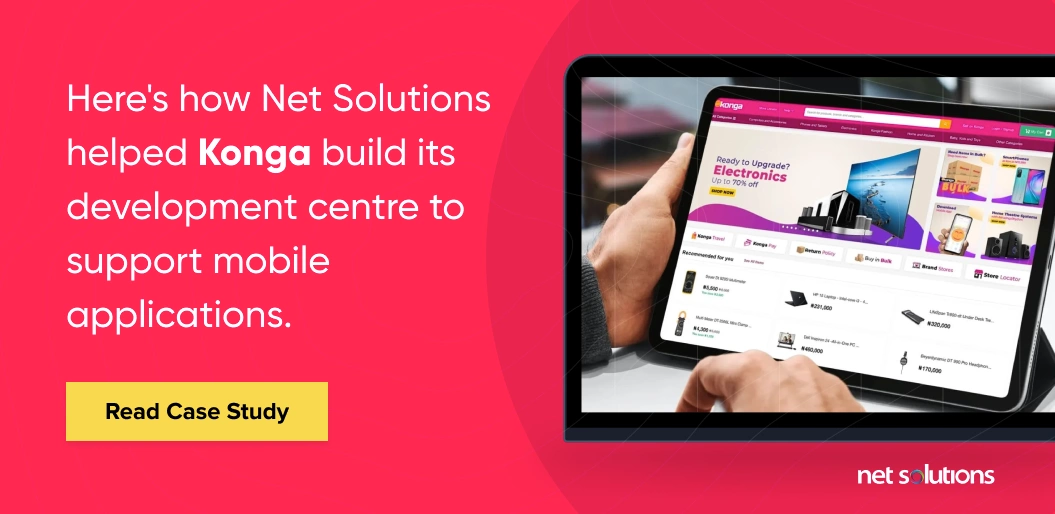
With the above-given reasons, one can imagine that a Mobile eCommerce App is a boon for your online business as it engages more customers and connects your business with the target audience. Therefore, to have a strong clientele with higher revenues, building an eCommerce mobile app following the given process will be your first giant step towards popularity and conversions.
Frequently Asked Questions
1. How do I decide which platform to develop my mobile eCommerce app for?
To decide which platform to develop your mobile eCommerce app for, consider factors such as your target audience, budget, development resources, and desired features and functionality. iOS and Android are the two most popular platforms, but there are also options for cross-platform development using tools like React Native and Flutter.
2. What is the cost of developing a mobile eCommerce app?
The cost of developing a mobile eCommerce app can vary widely depending on the platform, features, complexity, and development resources. Developing a mobile app can cost anywhere from $10,000 to $250,000. Working with an experienced development partner and carefully defining your project scope and budget before beginning development is important.
3. How do I measure the success of my mobile eCommerce app?
Measuring the success of your mobile eCommerce app requires tracking key performance indicators such as downloads, user engagement, retention, and revenue. It’s important to set clear goals and metrics for your app and to regularly track and analyze user feedback and analytics data to identify areas for improvement and optimization.
4. How do I integrate payment gateways in my mobile eCommerce app?
Integrating payment gateways in your mobile eCommerce app requires working with a payment gateway provider and integrating their API into your app’s backend. It’s important to choose a reputable payment gateway provider that supports your desired payment methods and currencies and to ensure your app fully complies with relevant security and regulatory standards.
SHARE THIS POST
Table of Contents
Related Resources
- eCommerce App Development Cost: Budgeting In-Depth Guide
- 13 Differences Between B2B and B2C eCommerce Websites
- Top 10 eCommerce Challenges and Easy Ways to Overcome Them
- 3 Types of eCommerce Business Models That Work in 2024
- eCommerce for Business: Is eCommerce Applicable for All Business Types
- eCommerce Customer Journey Mapping - The Secret to Higher Conversion Rates
- What is Headless Commerce? The Ultimate Guide
- Top 15 eCommerce KPIs to Track the Performance of Your Online Business
- What is Adobe Commerce (Magento)? Everything You Need to Know in 2024
- Omnichannel Retail Strategy: A Comprehensive Guide
- Omnichannel vs Multichannel Retailing: The Complete Guide
- What is eCommerce Order Fulfilment? (And 6 Steps to Improve the Process)
- PCI Compliance: Everything You Need To Know
- The BEST Guide to eCommerce Personalization
- 12 Essential Factors for Choosing the Best eCommerce Platform
- The Ultimate Guide to Product Information Management (PIM) Systems for Ecommerce
- What is a Product Recommendation Engine (And How it Helps Boost Sales)
- eCommerce Replatforming: Challenges, Benefits, and Best Practices
- The Ultimate Guide to eCommerce Security
- Top 13 eCommerce Trends in 2024
- How Voice Search will Transform the Future of eCommerce
- What is Web Accessibility (And Why it Matters for Your eCommerce Business)

